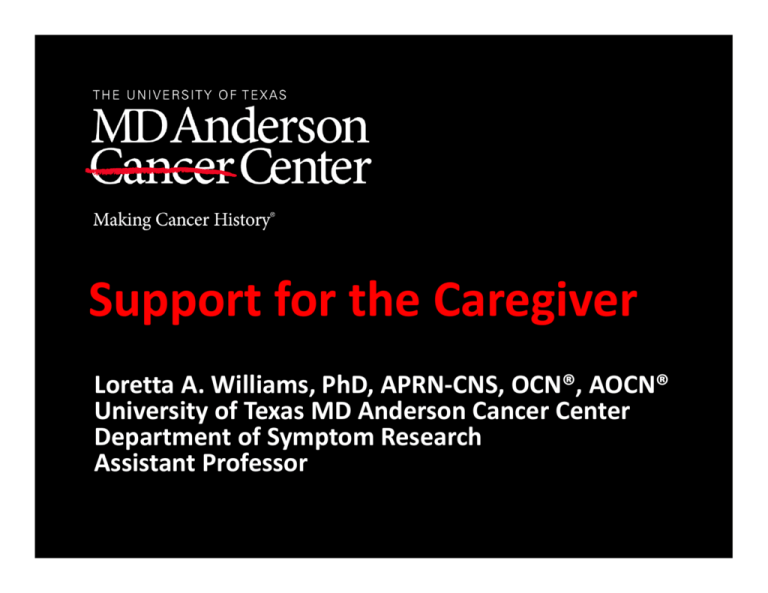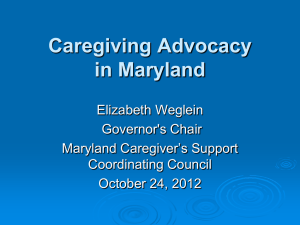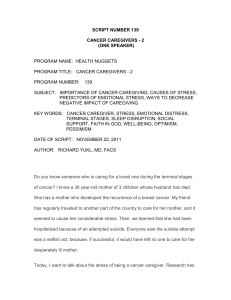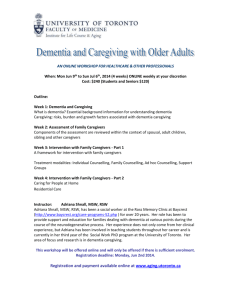Support for the Caregiver
advertisement

Support for the Caregiver Loretta A. Williams, PhD, APRN‐CNS, OCN®, AOCN® University of Texas MD Anderson Cancer Center Department of Symptom Research Assistant Professor Importance • Family (informal) caregiving Unpaid assistance, usually provided by family members, friends, or neighbors, to persons with health problems • 2009 caregiving value in US ‐ ~ $450 billion $600 Estimated Value in Billions $400 $200 $0 2003 2004 2005 2006 2007 2008 2009 Year • Informal caregiving is an essential component of cancer care Feinberg et al., 2011. AARP Public Policy Institute. Research Question What are the caregiver dynamics that energize informal caregivers of cancer patients? Predicted Caregiver Energy Sources • Commitment • Expectations • Negotiation Research Design • Qualitative descriptive exploratory study • Collect data with story dialogue • Analyze data by descriptive exploratory method Methods • Sample – 40 caregivers • Data Collection – Story Theory (Smith & Liehr, 2003) – One interview • Dialogue Guide • Story Path – Contextual Information • Caregiver Demographic Information • SF‐36 Health Status Form • Patient Demographic and Clinical Information • Data Analysis –Descriptive Exploratory (Parse, Coyne, & Smith, 1985) – Identify themes and elements – Descriptive statistics to analyze contextual information Results: Caregiver Descriptive Data Characteristic Age (Years) Years of Education Characteristic Gender Male Female Ethnicity African-American Caucasian Hispanic Marital Status Married Not Married Relationship to Patient Spouse Parent Child Other Mean 53.4 14.3 N S.D. 14.1 2.4 % 14 26 35.0 65.0 2 33 5 5.0 82.5 12.5 37 3 92.5 7.5 30 4 3 3 75.0 10.0 7.5 7.5 Results: Caregiver SF‐36 Scores Scale N Mean SD Physical Functioning Role Physical Bodily Pain General Health Vitality Social Functioning Role Emotional Mental Health Physical Component Summary Mental Component Summary 39 40 39 40 40 39 40 40 38 84.49 79.38 70.72 78.38 60.63 78.21 68.33 73.20 52.46 24.73 36.20 23.77 20.72 18.71 23.07 43.33 17.19 10.10 U. S. Population Means 82.97 77.93 70.23 70.10 57.0 83.56 83.10 75.22 50.00 38 47.70 10.70 50.00 Results Informal Caregiving Dynamics • Commitment – Self Care • Managing Expectations – New Insight • Role Negotiation – Role Support Commitment Elements • • • • Enduring Responsibility Making the Patient Priority Supportive Presence Self‐affirming, Loving Connection Enduring Responsibility I said to him, “I will do anything you want to do. I will go anywhere in the world. . . . But I will not sit here and do nothing.” . . . And he said, “Well, Honey, we can’t go down there and stay thirty days.” And I said, “I can go down there and stay a lifetime if that’s what it takes. But we need to do something.” And that’s when I figure I became his caregiver, right there on the spot. 64‐year‐old wife Making the Patient Priority I found my normal life slipping away, but not in a complaining way, just that’s what was happening. . . . I don’t know what a normal life is right now. . . . My focus is him. 65‐year‐old wife Supportive Presence I guess one of the things that has bothered me is the fact that my wife is sick, and I truly, I can’t do anything to make her well. . . . But I want to do all that I can do. . . . I want to keep my wife positive. When she’s down, I try to make her laugh. . . . When she’s feeling lonely, I try to speak with her. . . . Those are the things that I can do to try to have a pronounced positive effect on the outcome of her condition. 56‐year‐old husband Self‐Affirming, Loving Connection It changes your relationship from the standpoint it makes you stronger and more together, especially when your loved one struggles. . . . There really aren’t any secrets. . . . There’s just an openness and a togetherness. 58‐year‐old husband Maintaining Commitment Self Care Elements • • • • Getting Away from It Letting It Out Supportive Physical Environment Cultivating Healthy Habits Getting Away from It This time we had to get an apartment. And we feel this time that it really is much better because we leave the facility here completely. We go to an apartment where there is children around. . . . They are outside, you can hear them, there is regular people. 64‐year‐old mother caring for daughter Letting It Out He did have a lot of down, down days. We certainly had disappointments. . . . We called those our bumps in the road. . . . I am not a creative person. But one night at home all of this kept playing in my mind. And I just felt so led, and I got up and wrote a poem about a bump in the road. 66‐year‐old mother caring for son Supportive Physical Environment They have taken care of me just like they’ve taken care of him. I have had room service, you know. I have my Internet, that has been wonderful to have that access in there, that has been an outlet for me. 51‐year‐old wife Cultivating Healthy Habits I have to exercise. . . . I’m a fanatic about not wanting to gain weight, and I did gain weight last year when he went through all of this. . . . I think it helps the stress to workout, and. . . I find that helpful. The exercise really does do the work. 52‐year‐old mother caring for son Expectation Management Elements • • • • • Envisioning Tomorrow Getting Back to Normal Taking One Day at a Time Gauging Behavior Understanding Treatment Twists and Turns Envisioning Tomorrow You saw what might be your future in a little plastic bag. And it’s just not possible to fit that much in that plastic bag. But it really is possible. . . . And it was just remarkable to be able to look at that little bag and say, “This is what is going to keep us going, right here.” . . . Everything is all encompassing in that one moment. And you think of all of the things that have been, and you think of all of the things that might be. 56‐year‐old husband Getting Back to Normal I would hope that he’s going to be healthy, that he’s going to stay in remission from this. . . . We don’t have great hopes any more. We just want to do some things that are normal, and that’s really kind of what we are looking at. 32‐year‐old wife Taking One Day at a Time I don’t like the future. . . .When he went into remission and stayed there for several months, I tried to go back to normal and have hopes and dreams for the future. And then he relapsed. . . . After that I thought, “No more future for me. I’m not going to look that far into the future because we just don’t know with this kind of an illness what is going to happen.” 32‐year‐old wife Gauging Behavior She has been very hateful to me during this time. I take it. I don’t argue with her . . . because it is not her. That’s not her being like that, I know her, we’ve been married over 40 years. 60‐year‐old husband Reconciling Treatment Twists and Turns The cord blood was supposed to engraft in approximately 20 to 30 days. We kept waiting and we kept waiting. And it never did engraft. That was a real disappointment. . . . It just wasn’t adequate. 66‐year‐old mother caring for son Managing Expectations Gaining New Insights Elements • Experiencing Personal Growth • Leaning on the Lord • Recognizing Positive Outcomes Experiencing Personal Growth It helps you to learn more about yourself and what your relationship is with the people that you associate with on a day to day, and month to month, and year to year basis. Because they respond in ways that you didn’t anticipate. . . . And you take a lot of those relationships . . . for granted. So it’s been a learning experience in many different ways. 56‐year‐old husband Leaning on the Lord We’re just leaning on the Lord, because He’s all we have. . . . The doctors are doing their part, but they can’t do everything. 60‐year‐old wife Recognizing Positive Outcomes Once he turned the corner, now I’m getting back to my husband, I felt a lightness coming through, back to me. And I‘ve been fine the last four or five days. . . . A lot of it has to do with the fact that it’s behind us, that he seems to be doing all right so far, knock on wood. 65‐year‐old wife Role Negotiation Elements • • • • • Appropriate Pushing Getting a Handle on It Sharing Responsibilities Attending to Patient Voice Vigilant Bridging Appropriate Pushing I said to him last night, “Now that you’re no longer on the heavy medications, you’re going to have to start taking some responsibility. . . . Not all at once, because I know you’re still resting, and you’re tired, and you’ve been through a horrible trauma and ordeal. But . . . it can’t always be (me), because I’ve got to let go somewhat.” 65‐year‐old wife Getting a Handle on It The first time I walked into the hospital, and it said cancer center, I thought, “This happens to everybody but us.” And it’s like somebody puts a hot hand in the middle of your stomach and rips your guts out. . . . Once you walk into the clinic the first time, your life changes. . . . (You) try to understand . . . and to become as informed as you possibly can. . . . I want to be able to understand what’s going on and be able to support her from a rational standpoint and have rational and reasonable goals and expectations. . . . I think it’s important from a caregiver’s perspective. You can’t sit on the side lines, you have got to be involved. 58‐year‐old husband Sharing Responsibilities She needs 24‐hour care, watching. With having smaller children, that’s a problem because I need to be at home, homework, getting people ready for school. So that’s where your spouse or someone else in your family . . . can stay . . . until (you) get there. 33‐year‐old daughter‐in‐law Attending to Patient Voice I have learned, a big difference from last year to this year, . . . as far as the eating, sleeping. I just really go along with her. I used to say, “Oh, you have to eat. They say you have to eat.” It doesn’t work because . . . they get so sick. Now I just wait. And she will say to me, “Oh, I’m hungry. I would like so and so.” And I will then prepare it for her. . . . I listen to her. 64‐year‐old mother caring for daughter Vigilant Bridging As of right now, the insurance company isn’t letting us totally search for a donor. We have to be restaged, which will take place on Tuesday. Then (we’ll have) the usual play with the insurance company. I do have the medical director’s direct line, which I managed to weasel last time. So I imagine a few calls to her (will help). When she picks up, she gets very annoyed when somebody calls her office. So the last two times that I did it, the services we needed were approved within 20 minutes of my phone call to her. 35‐year‐old husband Supporting Role Negotiation Role Support Elements • Encountering Competent, Compassionate Care • Finding Support for Other Responsibilities • Knowing Others Care • Meeting Financial Obligations • Receiving Helpful Information Encountering Competent, Compassionate Care I have seen that all the nurses there have been so good, and they’re so attentive. And she has been taken care of very well. . . . I was pleased with that, and it eased my fear or anxiety. 71‐year‐old mother caring for daughter Finding Support for Other Responsibilities My husband has just totally surprised me. . . . He has totally changed. . . . He’s a Mr. Mom. . . . He has come around full circle. He does so much in the house, and he’s so proud. When I come home on the weekends, . . . the kitchen’s clean, the house (is clean). . . . He has done a great job. 52‐year‐old mother caring for son Knowing Others Care I found my way to a church. We had friends back home that helped us meet friends out here. So we immediately started with the church here and have made some of the closest friends we’ll probably ever have. They’ve just become our family. So we immediately were blessed with friends that nurtured us and still do. 66‐year‐old mother caring for son Meeting Financial Obligations They (the people at our church) . . . did a fundraiser and raised a bunch of money for us to help us. . . . And that was a relief (to know) you had that extra money. And it’s just about the right amount to cover the COBRA payments for probably the whole time we are going to be out here. 56‐year‐old wife Receiving Helpful Information That can definitely affect your caregiving role if you don’t have the community support, or you don’t know how to find community support. . . . Some hospitals I’ve found are better than others in helping you to know what supports are out there, giving you information. So if you don’t have a social worker or someone that is telling you, directing you in the right direction, it’s very difficult to access appropriate resources. And that definitely can be a benefit to you as a caregiver. 32‐year‐old wife Informal Caregiving Dynamics Informal caregiving dynamics are the commitment, expectation management, and role negotiation supported by self care, new insight, and role support that move an informal caregiving relationship along an illness trajectory. Implications for Practice • Recognize the significant commitment and sacrifices of family caregivers in providing care. • Acknowledge the unique contribution that family caregivers make to the patients’ care. • Give family caregivers the opportunity to tell or write their stories to assist them in resolving caregiving challenges. • Provide caregivers with clear, concise, realistic information about what to expect and how to provide care. • Provide caregivers with information and opportunities for self‐care activities. Future Research • Focus on the patient’s experience of the caregiving relationship. • Continue to est theory with caregivers of other types of patients. • Explore interventions suggested by model to improve caregiving outcomes for caregiver and patient. Further Use and Development • HSCT caregiver support program at M. D. Anderson Cancer Center • Research with caregivers of primary brain tumor patients at M. D. Anderson Cancer Center • Identification and intervention for high‐risk caregivers at City of Hope References Parse, R. R., Coyne, A. B., & Smith, M. J. (1985). The Descriptive Method. In Nursing research: Qualitative methods (pp. 91‐94). Bowie, MD: Brady Communications. • Smith, M. J., & Liehr, P. (2013). The theory of attentively embracing story. In M. J. Smith & P. R. Liehr (Eds.), Middle range theory for nursing (3rd ed., pp. 225‐251). New York: Springer. • Williams, L. A. (2003). Informal caregiving dynamics with a case study in blood and marrow transplantation. Oncology Nursing Forum 30, 679‐686. • Williams, L. A. (2007). Whatever it takes: Informal caregiving dynamics in blood and marrow transplantation. Oncology Nursing Forum, 34, 379‐387. • Williams, L. (2013). The theory of caregiving dynamics. In M. J. Smith & P. R. Liehr (Eds.), Middle Range Theory for Nursing (3rd ed., pp. 309‐327). New York: Springer. • Sometimes the only thing to do is to start looking at everything again until you forget what you're supposed to see and actually see what's there. Brian Andreas To Our Family Caregivers Questions and Discussion






